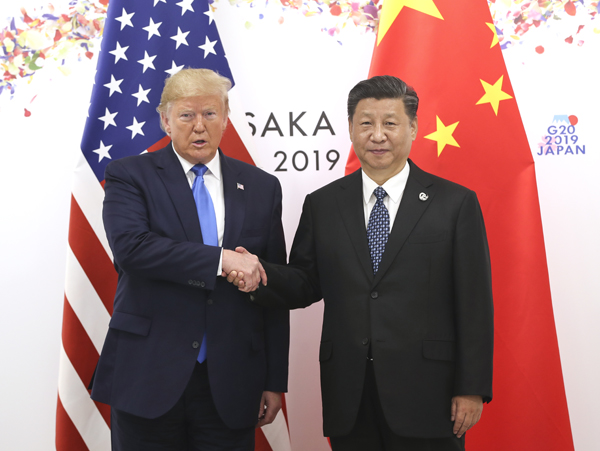Cease-fire raises hope of trade truce
By Liu Jianna | China Daily | Updated: 2019-07-04 07:02

Editor's Note: The much anticipated meeting between President Xi Jinping and his US counterpart Donald Trump on the sidelines of the G20 Summit in Osaka, Japan, on Saturday helped restart the trade talks to settle bilateral trade disputes, which have roiled the global market and dimmed its growth prospects. Three experts share their views on the meeting and China-US trade negotiations with China Daily's Liu Jianna. Excerpts follow:
Need to adopt cautious attitude toward US moves
Despite the decision of China and the US to resume the trade talks to the relief of the global market, Beijing should adopt a cautious attitude toward Washington's moves given the latter's attitude in the previous 11 rounds of bilateral trade talks. That the US leader said he harbors no hostility toward China should be judged by the actions he takes in the future. Besides, the influence the China hawks represented by US Secretary of State Mike Pompeo and White House Trade Advisor Peter Navarro exert on Trump remains to be seen.
The only certainties that have emerged from the Osaka meeting is that the trade talks would resume and the US would not impose tariffs on more Chinese goods. Whether a deal could be reached and what that deal would be are still unclear. However, the possibility that an agreement that satisfies the basic, not all, demands of both countries would be eventually signed cannot be ruled out.
Since Trump will focus on the presidential campaign next year and try everything possible to be re-elected, the inking of a deal with China, which could boost his chances to win the election, looks more likely.
Tao Wenzhao, a researcher in US studies at the Chinese Academy of Social Sciences
How to get along with each other
China and the US have decided to return to the negotiation table and chosen to not escalate the trade war, which reflects their willingness to cooperate amid mounting uncertainties in bilateral relations. And once again a meeting between the two heads of state has provided the direction for the development of bilateral ties.
But despite the positive signals, uncertainty remains, not least because the tariffs on $250 billion worth of Chinese goods are still in place, so are the differences that have prevented the two countries from concluding a trade deal, which are likely to sap the market. What's certain is that the US' policy to contain China's rise in the field of science and technology will not change easily even though Trump has softened his stance on Huawei.
In the long term, the two countries need to find a way to get along by respecting each other's core interests. Organizations and economies including the International Monetary Fund and the European Union hope China and the US would resolve their trade disputes, as they are harming the global economy. And to strengthen cooperation to meet common global challenges such as climate change, it is important to smooth the rough edges in bilateral relations.
Fu Mengzi, vice-president of the China Institutes of Contemporary International Relations
Right decision at the right time
That China and the United States have seized the window of opportunity and called a cease-fire in their trade row can be attributed to the compromise on both sides.
By calling a cease-fire in the trade row, the world's two largest economies have sent a strong signal across the globe that they want to resolve their trade disputes, which helped stock markets worldwide to stage a rally on Monday. The fact that both countries and the world beyond have started to feel the pinch of the trade war, to some extent, helped the two sides to step down a bit in order to resolve their trade frictions.
The opposition of a large number of US high-tech companies, and consumers and industry organizations to the trade war could seriously impair the US administration's ability to play the card of a booming economy, which the president relies on to be re-elected in 2020.
Yet, irrespective of the Trump administration's emphasis on defending US economic interests, the US has basically formed a strategy to portray China as a main rival that involves a fierce competition in core areas, strategic security, geopolitics, and science and technology. As a result, more disputes on multiple fronts could be the new normal for China-US relations even if a trade deal is eventually inked.
Bilateral trade ties that increasingly look like the only bond connecting the two countries now should be valued and made the ballast for promoting Sino-US relations, instead of being made a tool to champion American interests. As Xi said, cooperation brings benefits for both countries while conflict incurs losses on both sides.
Zhang Monan, deputy director of and a research fellow at the Institute of European and American Studies, China Center for International Economic Exchanges
The views don't necessarily represent those of China Daily.
























